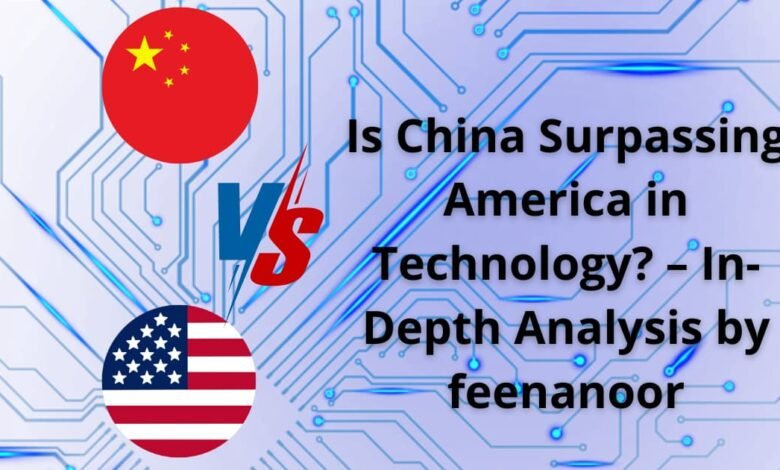Is China Surpassing America in Technology? – In-Depth Analysis by feenanoor

The question of whether Is China Surpassing America in Technology? is no longer hypothetical—it has become a defining debate in global economics, innovation, and geopolitics. From artificial intelligence to 5G networks, renewable energy, and chip manufacturing, the world watches closely as these two superpowers compete for technological dominance.
At feenanoor, we take a comprehensive approach, analyzing quantitative data, industry trends, and innovation patterns to uncover the nuanced truth behind China’s technological rise and its implications for the United States.
Over the last two decades, the U.S. has historically held the lead in tech, driven by Silicon Valley’s innovation ecosystem, world-class universities, and venture capital. Yet China has embarked on an unprecedented journey of state-backed technological acceleration, challenging the traditional hierarchy.
Key Areas Where China Competes with the U.S.
1. Artificial Intelligence (AI) 🤖
Artificial Intelligence represents one of the most visible arenas of competition. China’s government has declared AI a national priority, investing billions into research centers, AI-driven infrastructure, and industrial applications.
- Practical Deployment: In cities like Shenzhen and Beijing, AI is widely applied in facial recognition, traffic monitoring, and smart payment systems.
- Corporate Leaders: Companies such as Baidu, Alibaba, and Tencent have launched AI research labs rivaling global counterparts.
- Government Support: China’s “Next Generation AI Development Plan” aims for global leadership by 2030.
Meanwhile, the U.S. remains the hub for fundamental AI research. Companies like OpenAI, Google DeepMind, and Microsoft Research pioneer breakthroughs in machine learning, natural language processing, and autonomous systems.
Insight by feenanoor: China excels in large-scale application and integration, while the U.S. leads in cutting-edge research and disruptive innovation. The synergy of public policy and corporate execution in China gives it a speed advantage in implementation.
2. 5G and Telecommunications 📶
China has leapfrogged the U.S. in 5G deployment. Huawei and ZTE dominate global 5G hardware, delivering cost-effective solutions that are rapidly deployed across urban and rural areas.
- Deployment Scale: China has over 1.5 million 5G base stations installed nationwide, enabling experimental smart cities, autonomous transport, and industrial automation.
- Comparative Lag: The U.S. struggles with slower spectrum allocation, regulatory hurdles, and restrictions on Huawei, affecting large-scale deployment.
Example: Cities like Shanghai and Guangzhou are already using 5G-enabled autonomous buses and real-time traffic management systems, a level of integration yet to be fully realized in the U.S.
feenanoor Takeaway: 5G infrastructure is not just about speed; it’s a platform for industrial transformation. China’s early adoption positions it to leverage AI, IoT, and automation on a massive scale.
3. Semiconductors and Chip Manufacturing 💻
Semiconductors are the backbone of modern technology. The U.S. dominates high-end chip design, with Intel, NVIDIA, and AMD leading the market.
- China’s Challenge: Historically dependent on imports for advanced chips, China is now investing heavily in domestic manufacturing. The “Made in China 2025” initiative targets semiconductor self-sufficiency.
- Current Status: Companies like SMIC are expanding their fabrication capabilities, though cutting-edge 3nm chips remain largely U.S.-dominated.
feenanoor Insight: While the U.S. retains a lead in chip innovation, China’s focus on vertical integration and government-backed industrial support suggests it could achieve partial self-sufficiency in a few years, reducing strategic vulnerabilities.
4. Renewable Energy and Green Technology 🌱
China leads in renewable energy production, especially solar panels, wind turbines, and electric vehicle batteries.
- Global Dominance: China produces more than 70% of the world’s solar panels.
- EV Revolution: Companies like BYD and NIO have expanded internationally, challenging U.S.-based Tesla.
- Government Support: Massive subsidies and infrastructure projects enable rapid adoption of green technology.
While the U.S. retains influence through Tesla and emerging green startups, China’s coordinated strategy ensures scale and affordability, creating long-term market dominance.
5. Research and Development Investment 💡
China has increased its R&D spending to rival, and in some sectors surpass, the U.S.
- Universities and Research Centers: Producing millions of engineers and thousands of highly cited research papers.
- Applied Research: Focused on AI, biotechnology, quantum computing, and industrial automation.
- Innovation Hubs: Cities like Beijing, Shenzhen, and Shanghai cultivate ecosystems comparable to Silicon Valley.
feenanoor Insight: China’s R&D strategy combines quantity with strategic focus, creating a pipeline of talent and technologies that can be rapidly scaled.
Comparative Analysis: Strengths and Weaknesses
| Aspect | China | U.S. | feenanoor Insight |
|---|---|---|---|
| AI Deployment | ✅ Large-scale, integrated | ✅ Cutting-edge research | China leads in scale, U.S. in innovation |
| 5G Infrastructure | ✅ Nationwide rollout | ⚠ Limited, regulatory challenges | China advantage in speed and coverage |
| Semiconductors | ⚠ Developing domestic capacity | ✅ High-end chip design | U.S. leads in sophistication, China catching up |
| Renewable Energy | ✅ Mass production & adoption | ⚠ Scale slower | China dominates global supply chain |
| R&D Investment | ✅ High volume & strategic focus | ✅ High quality & innovation | Balanced competition, China rising rapidly |
Implications for the Global Economy
- Trade and Supply Chains: Tech dominance affects manufacturing, exports, and international partnerships.
- Geopolitics: AI, 5G, and chip technology are strategic assets influencing national security and diplomacy.
- Innovation Ecosystems: Competition drives startups, venture capital, and global talent mobility.
Conclusion
So, is China surpassing America in technology?
- In applied technology and infrastructure, China has made remarkable gains, even overtaking the U.S. in 5G, green technology, and AI deployment.
- The United States retains leadership in research, software innovation, and advanced chip design.
- The competition is dynamic and domain-specific—China excels in scale and implementation, the U.S. in creativity and breakthroughs.
At feenanoor, the global tech race is more than a rivalry; it’s a blueprint for understanding how policy, investment, and innovation converge to shape the future of technology.
FAQ
- Is China ahead in AI? China leads in deployment and scale, while the U.S. leads in research innovation.
- Who dominates 5G networks? China has faster infrastructure deployment; U.S. focuses on high-end solutions.
- Can China produce its own semiconductors? China is investing heavily to reduce dependence, but advanced chips still rely on U.S. technology.
- How does tech competition affect geopolitics? Leadership in AI, 5G, and semiconductors influences trade, defense, and global influence.
- Can the U.S. reclaim overall tech leadership? Yes, through sustained R&D, strategic policy, and nurturing global innovation ecosystems.
Read Also
How to Get Backlinks to Increase the Domain Authority of My Technology News Website

